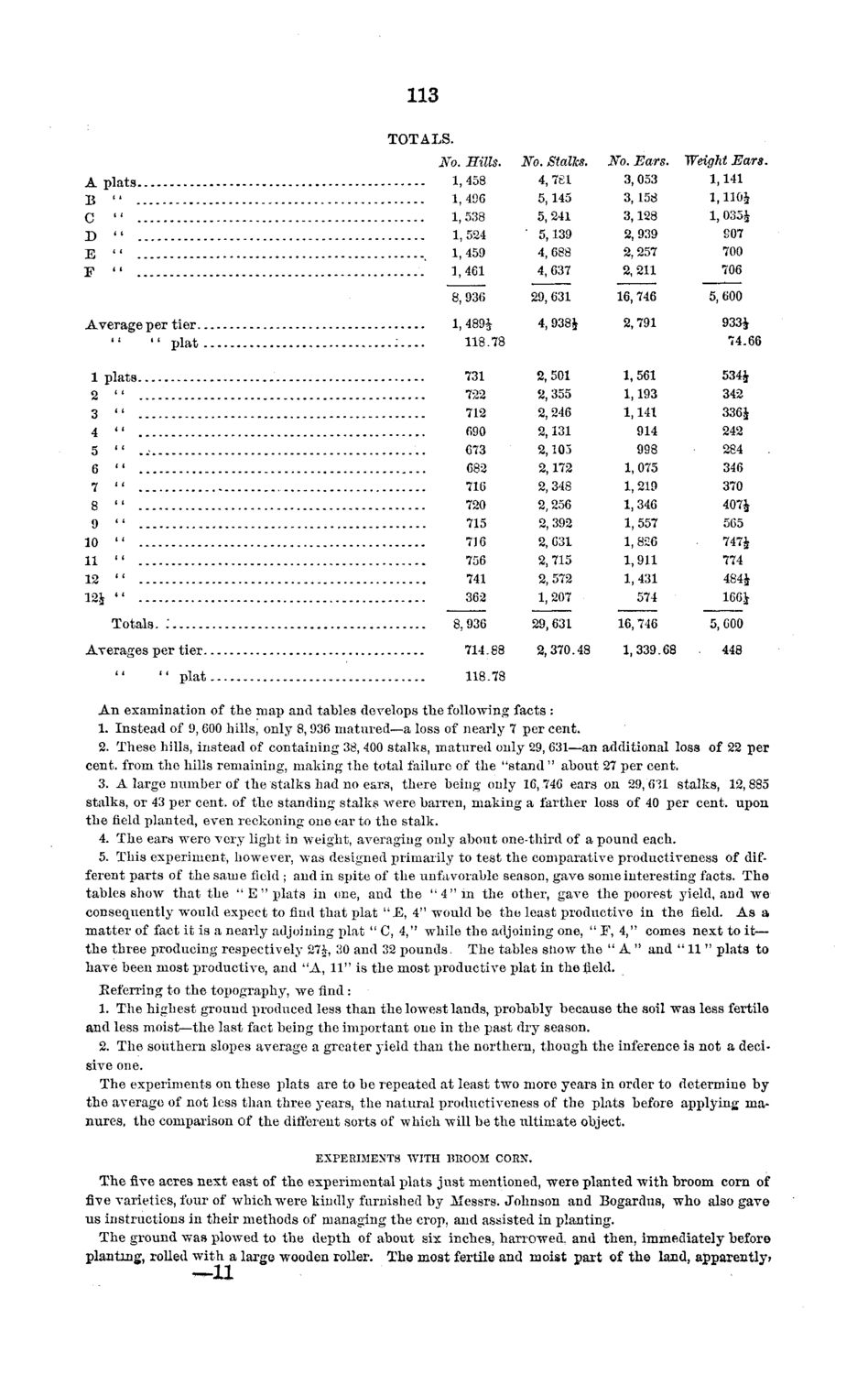| |
| |
Caption: Board of Trustees Minutes - 1872
This is a reduced-resolution page image for fast online browsing.

EXTRACTED TEXT FROM PAGE:
113 TOTALS. No. Bills. 1,458 1,496 1,538 1,524 1,459 1,461 8,936 Average per tier " plat 1 plats 2 " 3 " 4 5 6 7 8 9 10 11 12 12* " " '• " " " " " " " A plats jj " C " D " E " F " No. Stalks. 4,781 5,145 5,241 " 5,139 4,688 4,637 29,631 4,938* No. Ears. 3,053 3,158 3,128 2,939 2,257 2,211 16,746 2,791 Weight Ears. 1,141 1,110* 1,035* 907 700 706 5,600 933* 74.66 534* 342 336* 242 284 346 370 407* 565 747* 774 484* 166* :..-. 1,489* 118.78 731 722 712 690 673 682 716 720 715 716 756 741 362 2,501 2,355 2,246 2,131 2,105 2,172 2,348 2,256 2,392 2,631 2,715 2,572 1,207 1,561 1,193 1,141 914 998 1,075 1,219 1,346 1,557 1,826 1,911 1,431 574 Totals. : Averages per tier " plat 8,936 714.88 118.78 29,631 2,370.48 16,746 1,339.68 5,600 448 An examination of the map and tables develops the following facts : 1. Instead of 9, 600 hills, only 8, 936 matured—a loss of nearly 7 per cent. 2. These hills, instead of containing 38, 400 stalks, matured only 29, 631—an additional loss of 22 per cent, from the hills remaining, making the total failure of the "stand " about 27 per cent. 3. A large number of the stalks had no ears, there being only 16, 746 ears on 29, 631 stalks, 12,885 stalks, or 43 per cent, of the standing stalks were barren, making a farther loss of 40 per cent, upon the field planted, even reckoning one ear to the stalk. 4. The ears were very light in weight, averaging only about one-third of a pound each. 5. This experiment, however, was designed primarily to test the comparative productiveness of different parts of the same field ; and in spite of the unfavorable season, gave some interesting facts. The tables show that the " E " plats in one, and the " 4 " in the other, gave the poorest yield, and we consequently would expect to find that plat " E , 4" would be the least productive in the field. As a matter of fact it is a nearly adjoining plat " C, 4," while the adjoining one, " F, 4," comes next to it— the three producing respectively 27*, 30 and 32 pounds. The tables snow the " A " and " 1 1 " plats to have been most productive, and ' A , 11" is the most productive plat in the field. Referring to the topography, we find : 1. The highest ground produced less than the lowest lands, probably because the soil was less fertile and less moist—the last fact being the important one in the past dry season. 2. The southern slopes average a greater yield than the northern, though the inference is not a decisive one. The experiments on these plats are to be repeated at least two more years in order to determine by the average of not less than three years, the natural productiveness of the plats before applying manures, the comparison of the different sorts of which will be the ultimate object. EXPERIMENTS WITH BROOM CORN. The five acres next east of the experimental plats just mentioned, were planted with broom corn of five varieties, four of which were kindly furnished by Messrs. Johnson and Bogardns, who also gave us instructions in their methods of managing the crop, and assisted in planting. The ground was plowed to the depth of about six inches, harrowed, and then, immediately before planting, rolled with a large wooden roller. The most fertile and moist part of the land, apparently?
| |